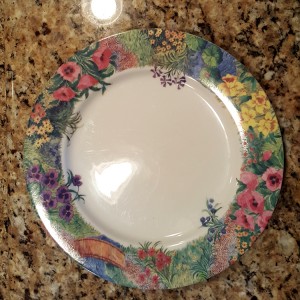Recently I was invited over to my mom’s friend’s house to paint glass. I’ve painted several things–canvases, paper, flower pots, houses, walls–but not glass, so I thought I’d try. I brought a little glass and a set of three clear pitchers to paint. (I don’t have a picture of the glass, but I’ll paint more as the original designs wear off & post them together.)
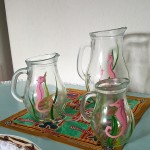
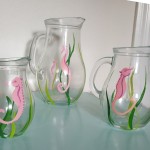
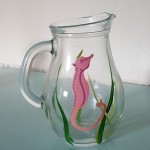
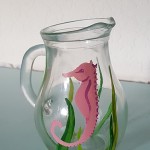
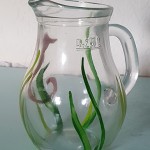
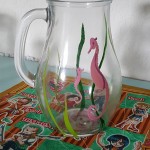
It was sometimes tricky to paint consistently on the curvy sides–to keep a smooth, continuous stroke and to apply a consistent amount/thickness of paint. Only one thing for it: practice.
If you want to try this on your own, here are the steps:
- Step 1. Find clear objects. (Granted, you can paint just about anything; it doesn’t have to be glass.)
- Step 2. Gather art supplies: brushes of different sizes, water to clean them, paints, something to mix colors on if you want to, a varnish, and a cleaning solution.
- Notes: We used little tubs of a special acrylic paint for glass, ceramics, etc. (PermaGloss, maybe? The name had “perma” in it. DecoArt is another brand.) The paints seemed smoother & more liquidy than my regular acrylic paints. You might be able to use regular acrylics, but I don’t know for sure since I have not experimented with them. I hope to some time.
- Step 3. Clean the objects to be painted. Wash with soap & water. Dry. Make sure there is no lint on them. Then, using a brush, apply a layer of cleaning solution. We used a bottle of some sort of craft cleaner–basically rubbing alcohol. Anything of that sort would do. Let dry (10 minutes should be sufficient for the alcohol solution to dissolve).
- Step 4. Imagine! What do you want to paint? You can sketch some designs on small pieces of paper and tape them to the inside of the glass and use them as a template, or you can paint freehand.
- Step 5. Paint. If you mess up, you can wipe away the offending paint with a moist paper towel & then a dry one to remove streaks.
- Step 6. Let the objects dry completely once you have finished painting. Acrylics dry quickly (in a matter of minutes), but I would leave them alone longer. You can clean your brushes while you wait.
- Step 7. Apply enamel with a clean, dry brush. Cover only the areas you painted. We used DuraClear gloss & satin varnishes (polyurethane).
- Step 8. Let objects stand 10 days while gloss settles, cures, dries, & whatever other verbs it does. Put the objects in a safe place out of the way of activity, dust, pets, and such. After 10 days, your newly painted objects will be dishwasher-safe and ready to use!
You can also do this to cover chips on dishes! Can you find where I repainted this china plate? (I promise it’s not where the reflections are.) Click to enlarge; it’ll help the looking.

